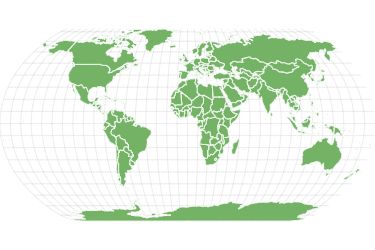Squid
Teuthida
Some species are known to have 10 arms!
Advertisement
Squid Scientific Classification
Read our Complete Guide to Classification of Animals.
Squid Conservation Status
Squid Facts
- Main Prey
- Fish, Crabs, Shrimp
- Habitat
- Cooler and temperate waters
- Predators
- Human, Seal, Whales
- Diet
- Carnivore
- Average Litter Size
- 5
The eyeball of a giant squid is about 10.5 inches (26.67 cm) in diameter, about the same size as a soccer ball!
There are about 300 different species of squid. They are found in all of the oceans throughout the world, including n the freezing cold Antarctic waters. They eat a range of different foods, including tiny animals such as krill, some fish, and even each other. Squid usually live about 3 to 5 years, but some large squid have been known to live as long as 15 years. Although they have some things in common with octopuses, a squid and an octopus are completely different animals.
5 Squid Facts
- Some squid have special cells in their skin that allows them to change colors.
- Most squids have 8 arms and two longer tentacles, but some squids have 10 arms.
- Squid have tough beaks that they use to kill and eat their prey.
- Many squids that live in deep water have bioluminescent organs that show through their skin.
- Squids are one of the few animals that have multiple hearts. In total, squids have three hearts!
You can check out more incredible facts about squids.
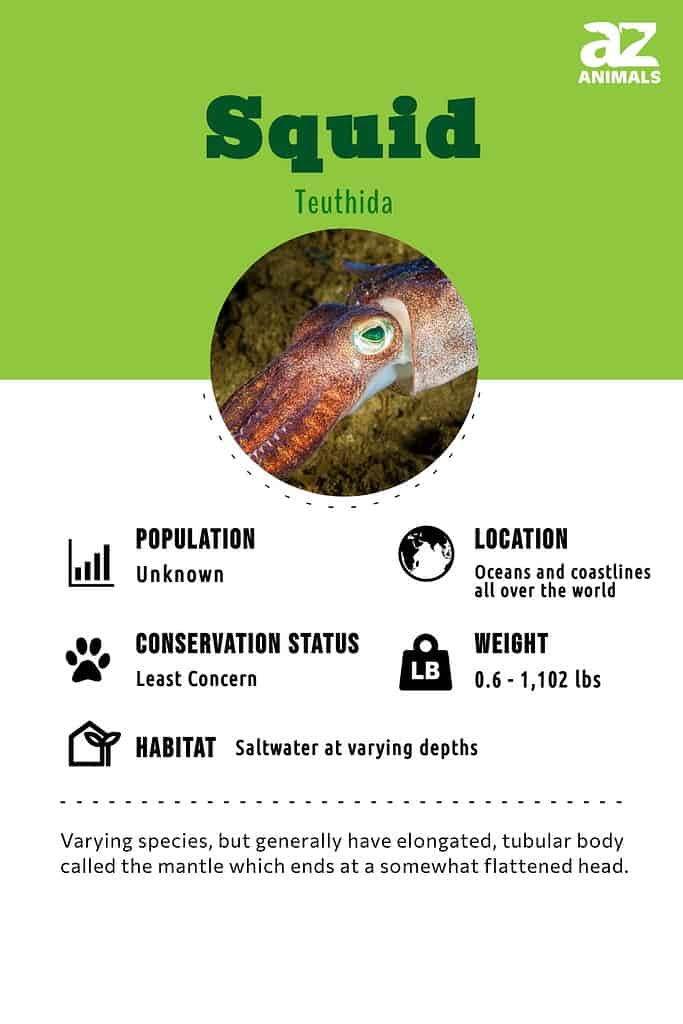
Scientific Name
Because so many different kinds of squids exist, there are hundreds of different scientific names for them. All are cephalopods, which means they are members of the scientific class Cephalopoda, along with octopuses and cuttlefish. The class name comes from the Greek words for head and foot. They are members of the superorder Decapodiformes, which is derived from the Greek words for 10 feet. Squids belong to the order Teuthida, a term that comes from the Greek word for fierce.
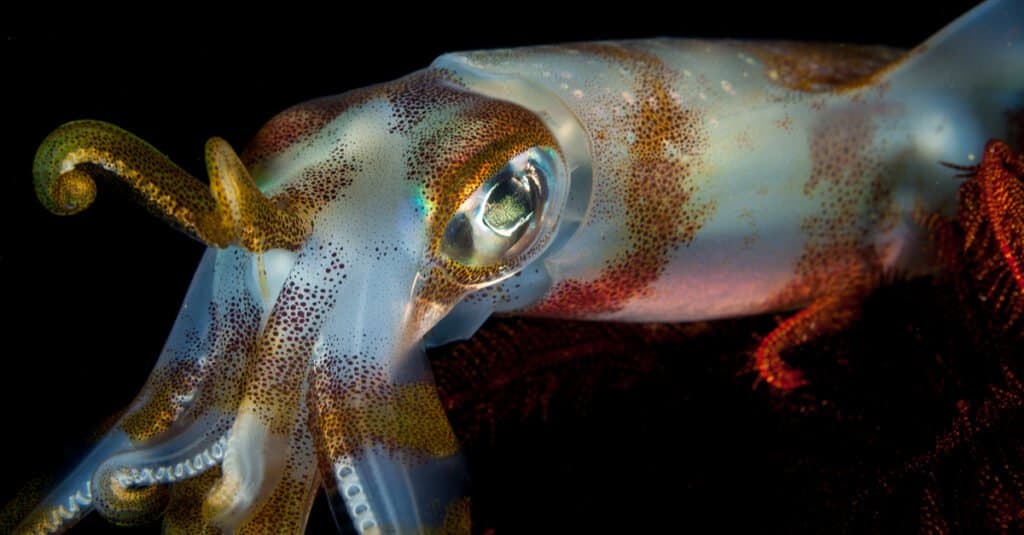
All squids are cephalopods.
©Gerald Robert Fischer/Shutterstock.com
Appearance and Behavior
Squids can look different from one another, depending on the species, but in general all squid have an elongated, tubular body called the mantle which ends at a somewhat flattened head. On either side of the mantle are fins that aid the squid in moving through the water. Depending on the species these fins can be quite large, running the full length of the mantle, or very small, located just at one end. A squid also has relatively large eyes, one on either side of its head, that allow it to see 360 degrees around it.
At the lower end of the squid’s body are the arms and tentacles, attached to the head. Each of the arms has suckers on it, as do the tentacles. The suckers of some squids are also armed with sharp hooks that allow them to grip their prey tightly. They don’t have a skeleton as we do, but squid does have a small, internal skeleton made of chitin, which is the same thing you’ll find on the outside of an insect.
The shape of the squid allows it to slip quickly through the water. When swimming slowly it uses its fins for propulsion, but if the squid is in a hurry it moves by taking in water through its mantle and then squirting it out through its siphon, jet-propelling it through the water. The siphon can be moved to point in any direction, allowing the squid to quickly move in whichever way it chooses.
Squids are usually black, white, brown, or gray, but many of them can change their appearance at will. The Humboldt squid, for example, can flash red and white, and other squids can match their color to their surroundings or display a colorful pattern on their bodies. They can use color to signal to other squid or to help camouflage themselves to avoid predators.
Deep-sea squid often have bioluminescent organs, and these lighted body parts can be seen from outside the animal. Typically, $squid can also squirt out a cloud of ink in the event they feel threatened. The ink hides them and gives them time to escape to safety. A notable exception to this is the vampire squid, which squirts out a sticky bioluminescent cloud into the water which glows for about 10 minutes, giving the vampire squid time to get away.
Squid come in many different sizes. The heaviest squid on record was a colossal squid discovered in New Zealand in 2007. This huge animal weighed more than 1,000 pounds (453.6 kg), almost as heavy as a grizzly bear. The longest squid ever found was a giant squid. While not as heavy as a colossal squid, the biggest giant squid was 49 feet (14.9 meters) long, longer than a semitrailer. Most squid are much smaller, with the average being about 2 feet (60 cm) long, the size of an average man. The smallest squid known is the Southern pygmy squid, which is practically invisible at only ¾ of an inch (1.6 cm) long.
Squids tend to live alone, but they do sometimes gather in groups and some of them have even been known to hunt cooperatively, similar to the way a pack of wolves hunts. When they do gather a group of squid is called either a shoal or a squad, with the exception of the giant squid. A group of the giant squid is called a school.
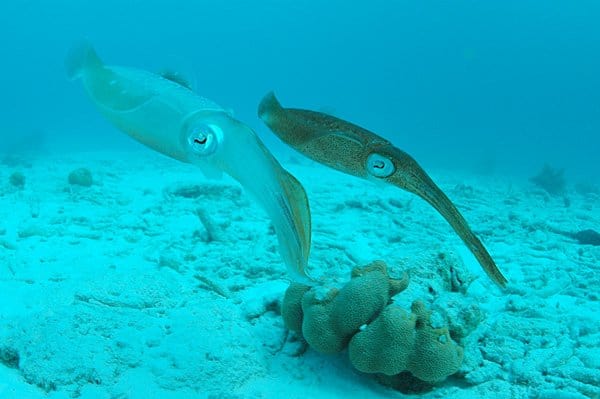
History and Evolution
It is believed that squid evolved 50 to 60 million years ago and from shelled mollusks that are ancestors of what we see today. Even more interesting, it may appear that they also evolved from a prehistoric snail. It may beg the question of where the snail shell disappeared, but the remainder of shells, or hints of them, are found in other animals with common ancestry. They are like little clues to investigating the family trees of the past for animal species. From such evolutionary evidence you can see that the cuttlefish has what is called the cuttlebone, which is a leftover clue of having a shell. Nautili also have internal and external examples of remaining shell.
Another fascinating feature of squid evolution is how they came to have eight arms and two tentacles. Scientists have found evidence that these very useful appendages actually are very similar to the foot of snails and other similar bivalves. Squids have amazingly adapted and evolved their singular foot to become how we know them to be today.
Types of Squid
There are hundreds of different types of squid across the world. These are just a few of them!
- Colossal Squid – The Colossal Squid is incredibly large with a weight of at least 1,090 pounds and a length estimated between 30-33 feet. This size makes the colossal squid the largest squid in the world. Colossal squid are believed to be ambush predators and use bioluminescence to attract their prey. These squid are believed to primarily inhabit the Southern Ocean circumferential to Antarctica up to 13,000 feet deep. Because they live at such extraordinary depths, much is left to be learned about these creatures.
- Vampire Squid – The Vampire Squid usually exist in deep sea and use bioluminescent organs and oxygen metabolism to survive parts of the sea that have extremely low levels of oxygen. This sea creature resembles both squid and an octopus. However, it is none of the two. It has eight arms and two tentacles. The vampire squid’s name comes from its dark color and also the skin that connects it’s multiple arms – forming a cape-like structure. Vampire squids have two filaments. However, these sea creatures are only able to extend one filament that helps these fishes overcome energy deficiencies in areas where the concentration of oxygen is low.
- Humboldt Squid – The Humboldt Squid, often called the jumbo squid, can grow up to 110 pounds with a maximum length of up to 7 feet. This squid is found in the eastern Pacific ocean and is the largest of the flying squid. They are most often found in large shoals of about 1,200 individuals and live at depths between 660 and 12,300 feet. They can swim up to 15 miles per hour and are vicious predators. They primarily feed on other mollusks, small fish, and crustaceans, but are also frequent cannibals. In pursuit of prey, Humboldt squid chase down and attack using their barbed tentacle suckers. They then tear apart the prey’s flesh with their razor sharp, parrot-like beak. Each sucker has a ring of sharp teeth and the squid’s beak can easily tear tough tissue. There have been verified reports of human attacks, primarily on deep-sea divers.
- Bigfin Reef Squid – The Bigfin Reef Squid, also known as the glitter squid or oval squid, belongs to the loliginid squid family Loliginidae. They get their name from the large oval fin connected to the mantle. Although they rank as a medium-sized species and only measure around 1.5 to 13 inches long, they grow faster than almost any other large marine invertebrate. They engage in elaborate mating displays and live relatively short lives, with a maximum age of just 315 days.
- Robust Clubhook Squid – The Robust Clubhook Squid
- Giant Squid – The Giant Squidis estimated to weigh up to 606 pounds and is capable of reaching lengths between 39-43 feet, making it the longest squid in the world. Giant squid inhabit the deep-sea between an estimated 989-3,280 feet and have therefore been incredibly hard to study. Very few have been studied alive and most of what is known about them comes from studying carcasses that have washed up onto beaches. The giant squid’s diet consists of deep-sea fish species, other smaller squid, and possibly some whales. The giant squid is a solitary hunter and catches its prey using two tentacles with barbed suckers.
- Heterololigo Squid – The Heterololigo Squid, also known as the spear squid, is a genus of with only the Heterololigo bleekeri. It is known for its short tentacles and only lives for about one year. Japanese fisherman catch these off their coasts.
- Swordtip Squid – The Swordtip Squid, Uroteuthis edulis, is a commonly caught squid in the southern East China Sea. They have a lifespan of just nine months and spend most of this time migrating based on sea temperatures.
Habitat
Squids are found in oceans all around the world. Not all species live in all parts of the world. Some squid prefers warmer, tropical waters while others thrive in the cold seas where krill and other food can be found, but as a species, they can be found almost everywhere.
Unlike octopuses, which live in nooks in rocks and coral reefs, squid are free-swimming and do not seek a place to call home, though some of them do live near the ocean floor, which helps to hide them from their enemies.

Squid can be found all over the world.
©RobJ808/Shutterstock.com
Diet
For the most part, squid eats fish such as orange roughy, lantern fish, and hokie, along with other sea creatures such as oysters, crabs, and shrimp. Squids are also cannibals and will happily devour another squid, even of their own species, if they are hungry. The size of the prey depends on the size of the squad.
Humboldt squid is well-known for their aggressive nature, and they will consume anything it can catch. There have even been tales of shoals of them attacking and eating fishermen who are unlucky enough to fall into the water when the squid is present.
The vampire squid is different from most other squids because it doesn’t catch and eat live food, nor does it drink blood, as its name might suggest. Instead, it floats through the water waiting to catch detritus that falls through the water. This is made up of tiny dead animals and fecal pellets from other creatures. This squid then rolls everything it has caught into a ball and sticks it together with mucus, then eats the ball it has made.

Squids can be cannibals and will happily devour another squid, even of their own species, if they are hungry.
Predators and Threats
Because squid comes in a huge range of sizes and is found almost everywhere, many types of animals eat squid. Small squid is eaten by almost any kind of predator imaginable, but their main predators are penguins, seals, sharks such as the grey reef shark, whales such as the sperm whale, and humans.
Despite being a popular prey item, squid remains plentiful in the wild. According to the International Union for the Conservation of Nature (IUCN), squid is classified as having a status of Least Concern, which means that there are no immediate threats to squid known to exist, and their numbers in the wild are plentiful.
At least some types of squid have the ability to regenerate their tentacles, so if one is lost in an attack by a predator or in some other way, the $squid can eventually replace the lost part. Scientists do not believe that squids can regenerate their arms. Only their longer tentacles appear to have the ability to regrow.
Human Consumption
In general, squid is a source of food for human beings, and is under threat by overfishing. Squid is consumed as a cultural staple in places like Japan, where it is included in sushi cuisine. In Western culture, it is referred to by the Italian term calamari, served stuffed, as sliced rings, or as flat pieces.
Areas, where squid is caught, include the North Pacific, the Mediterranean, the East Coast of the U.S., and the Northeast Atlantic. It’s beneficial to humans for the vitamin and nutrients it contains, namely copper, manganese, zinc, selenium, vitamin B12, and riboflavin.
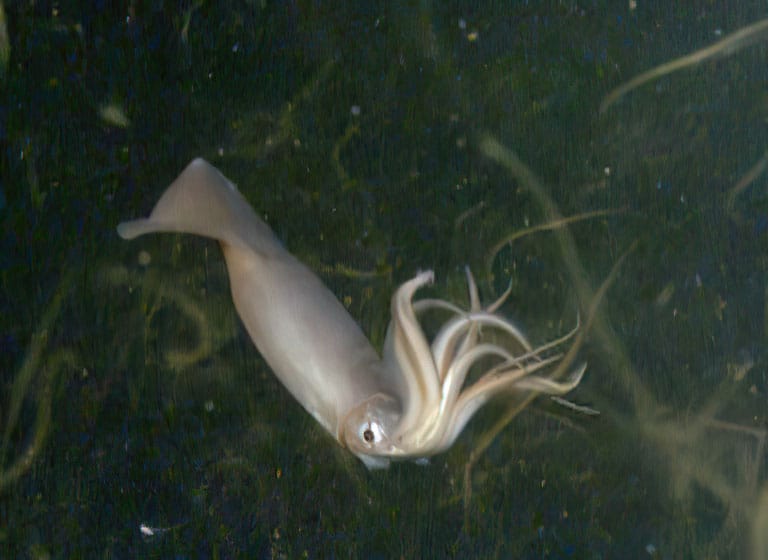
©Image courtesy of NOAA/MBARI 2006 / public domain – License
Reproduction, Babies, and Lifespan
Because there are so many different species of squid, some variation exists in how they reproduce and how long they live. Typically, squids mate in large groups and reproduce when the male places sperm into the female’s mantle. She can then store the sperm until she is ready to use it. When it is time, the female uses the sperm to fertilize her eggs and she will then lay her eggs on the ocean floor or attach them to seaweed. She will not care for them any further.
When the eggs hatch, the babies usually look like tiny copies of the adults and are known as paralarvae. They will grow and change as they mature, ultimately becoming squid that is able to care for themselves. The little squid absorbs their egg yolk initially, and this feeds them until they can catch food for themselves.
The lifespan of a squid is somewhat uncertain, but scientists think that most squids don’t live longer than 5 years in the wild, and many don’t survive even that long. The exception to this is the larger squid that lives deep in the ocean, some of which have been known to live up to 15 years. Most species die after reproducing.
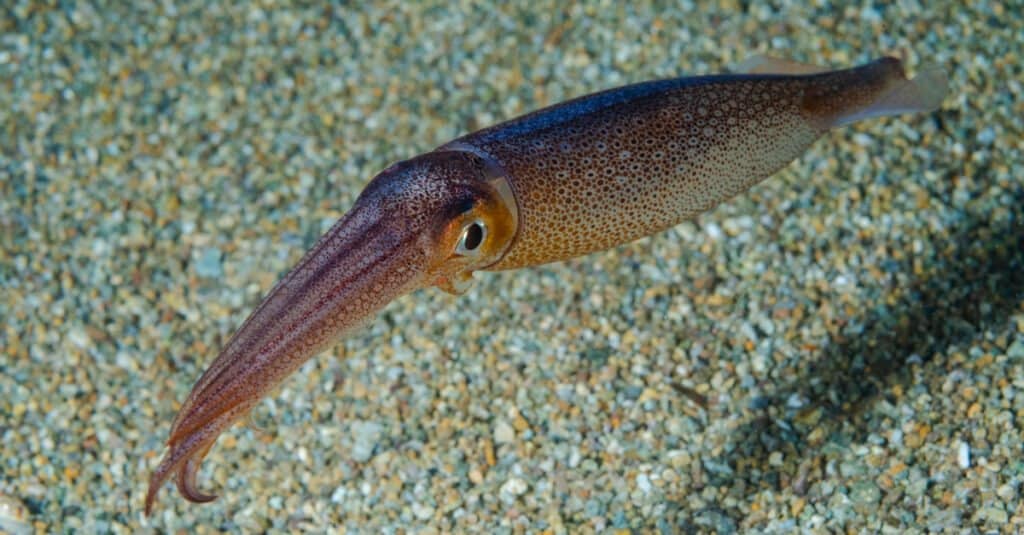
The lifespan of a squid is somewhat uncertain, but scientists think that most squids don’t live longer than 5 years in the wild, and many don’t survive even that long.
©Shpatak/Shutterstock.com
Population
The total population of all of the varieties of squid is impossible to know, but they number in the millions. The IUCN lists them as being of least concern, which means that squid are not considered threatened or endangered in any way. A drop in the squid population could spell disaster for many other species, as so many creatures depend on the squid for survival. One sperm whale, for example, can eat up to 800 squid in a single day, and elephant seals may consume large numbers of squid as an essential part of their diet.
View all 293 animals that start with SSquid FAQs (Frequently Asked Questions)
Is squid good for you to eat?
Many people around the world eat squid. It can excellent nutrition, but how good it is for you depends on how it is prepared. A 3-ounce serving of raw squid has only 78 calories and 15 carbohydrates. It also contains 13.2 grams of protein, along with a variety of essential vitamins and minerals, including copper, selenium, zinc, phosphorous, niacin, and B-12. Frying it more than doubles the calories while adding slightly to the protein, but it doesn’t add much else in the way of benefits.
Are octopus and squid the same thing?
While they may be somewhat similar in appearance, octopus and squid are not the same thing. They have different lifestyles, with the octopus living in a solitary den while the squid swims in the open ocean and may be found in large groups of squid, called shoals. Also, the squid has eight arms, two tentacles, and a pair of fins on its elongated mantle, while the octopus has eight tentacles, no fins, and a rounded head.
Is squid a fish?
No, a squid is not a fish. Fish are members of the phylum Chordata, which contains vertebrate animals. They have spinal cords and bones. Squid are members of the phylum Mollusca, which contains invertebrate animals. They do not have spinal cords or bones. Squids are cephalopods, which means that have their arms attached to their heads. Fish don’t have this type of construction.
How many tentacles does a squid have?
While it may look as though a squid has 10 tentacles, it actually has 8 arms and two tentacles. The squid uses its tentacles to grab its prey and then uses its arms to hold and control the prey. Its tentacles are much longer than its arms and can often be seen trailing behind the squid as it swims.
Can you eat squid ink?
Yes, squid ink is used in a variety of foods and is good to eat. It is used to make black pasta and is also used in seafood sauces and some sushi dishes. Squid ink is good for you, as it contains antioxidants, iron, and a number of other nutrients. It is black because it contains melanin, the same thing that gives human skin its pigment. A little bit of it adds a lot of flavor to foods.
Are squids carnivores, omnivores, or herbivores?
Squids are carnivores, living on a diet made up exclusively of meat, including fish and shellfish.
What Kingdom do Squids belong to?
Squids belong to the Kingdom Animalia.
What phylum do Squid belong to?
Squid belong to the phylum Mollusca.
What class do Squid belong to?
Squid belong to the class Cephalopoda.
What family do Squid belong to?
Squid belong to the family Oegopsina.
What order do Squid belong to?
Squid belong to the order Teuthida.
What type of covering do Squids have?
Squids are covered in Smooth skin.
In what type of habitat do Squid live?
Squid live in cooler and temperate waters.
What is the main prey for Squid?
Squid prey on fish, crabs, and shrimp.
What are some predators of Squid?
Predators of Squid include humans, seals, and whales.
What is the average litter size for a Squid?
The average litter size for a Squid is 5.
What is an interesting fact about Squid?
Some Squid species are known to have 10 arms!
What is the scientific name for the Squid?
The scientific name for the Squid is Teuthida.
What is the lifespan of a Squid?
Squids can live for 5 to 30 years.
How fast is a Squid?
A Squid can travel at speeds of up to 18 miles per hour.
What's the difference between cuttlefish and squid?
Cuttlefish are much smaller than squid, and they also have fans on either side of their head, which squids don’t typically have. Read all about their differences here!
Thank you for reading! Have some feedback for us? Contact the AZ Animals editorial team.
Sources
- David Burnie, Dorling Kindersley (2011) Animal, The Definitive Visual Guide To The World's Wildlife
- Tom Jackson, Lorenz Books (2007) The World Encyclopedia Of Animals
- David Burnie, Kingfisher (2011) The Kingfisher Animal Encyclopedia
- Richard Mackay, University of California Press (2009) The Atlas Of Endangered Species
- David Burnie, Dorling Kindersley (2008) Illustrated Encyclopedia Of Animals
- Dorling Kindersley (2006) Dorling Kindersley Encyclopedia Of Animals

